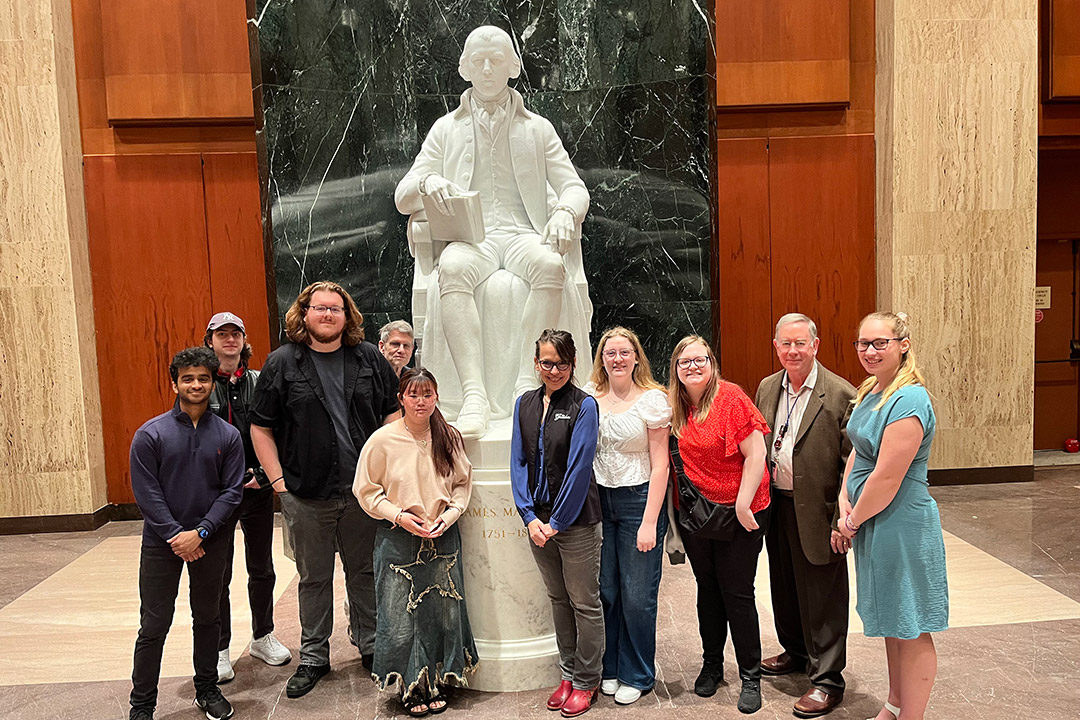Cultural heritage imaging system expands international impact to South America
RIT sends two new MISHA systems to Colombia to aide digital collections’ stewardship and research
Tom Blake
Juilee Decker, Roger Easton Jr., and eight students traveled to Washington, D.C., to launch the open-source system and software for the MISHA system at the Archiving 2024 conference held at the National Archives. This engagement, paired with the international deployments, are part of the group’s efforts to expand the community of those interested in multispectral imaging in the field of cultural heritage. As part of this event, the group toured the Library of Congress’ Digitization facilities with Tom Rieger, second from right, who serves as Chief of the Collections Digitization Division at the Library of Congress.
It can be gratifying and inspiring when a project’s positive impact goes beyond the original scope of the researchers’ imagination. This has been the case for scholars in RIT’s Cultural Heritage Imaging Lab as the Multispectral Imaging System for Historical Artifacts (MISHA) system extends its footprint to Europe and South America.
Led by Professor Juilee Decker, Professor David Messinger, and Professor Roger Easton Jr., the development of the MISHA system was originally planned to help small- to medium-sized cultural institutions in the United States. Following the recent system delivery to the State Archives in Dubrovnik, Croatia, a new collaboration with the National Library of Colombia (NLC) and an upcoming visit to the University of Sao Paulo in Brazil is further expanding use and application of the imaging technology.
This fall, representatives from the NLC will travel to RIT’s Henrietta campus to visit the Cultural Heritage Imaging Lab, housed in the Chester F. Carlson Center for Imaging Science, and receive training on the MISHA system. The goal will be for two new MISHA systems to be delivered to the NLC in the coming year. The student researchers and faculty from the RIT lab will remain in contact with the NLC to provide additional trainings and technical support via Zoom.
“The deployment to Croatia, the forthcoming deployment to Colombia, and our visit to the University of Sao Paulo this fall really demonstrate both the need and the willingness on the part of collection stewards to foster engagement through digital practices,” said Decker, program director of the College of Liberal Arts’ museum studies program. “I think it’s promising for our students to see the progression of how a research question can be answered and can push forward innovation in ways that we hadn’t conceptualized when we wrote the initial grant five years ago.”
The collaboration with the NLC was made possible through a new grant from the Whiting Foundation, which was driven by Chet Van Duzer, board member of the Lazarus Project, University of Rochester.
Van Duzer has made significant contributions to the field of multispectral imaging, having been the principle investigator on the grant project which imaged and analyzed the Henricus Martellus World Map at Yale University. Easton was part of the team of researchers who worked on the Martellus map and, when RIT received grant funding for the development of the MISHA system, Van Duzer was asked to serve as an adviser on the project.
Since the beginning of his involvement, Van Duzer was interested in how the technology could be utilized in South America. He began conversations with a variety of institutions in Colombia four years ago and, ultimately, it was determined that the NLC would become stewards of the new systems.
“This new partnership is something that really excites me. Particularly in Colombia, where a significant portion of the country is very humid, a lot of the departmental archives have this problem of humidity damaging their documents and rendering the text illegible overtime. So there’s a great opportunity to recover national patrimony. It’s really the perfect tool for archives in Colombia,” said Van Duzer.
The deployment of two MISHA systems to Colombia will enable scholars across the country to engage with the imaging technology. One system will be permanently housed at the NLC, and the other will travel the country to serve smaller archives and cultural institutions. Possible candidates to host the traveling system have already been identified by Anthony Picón Rodríguez, researcher at the NLC and co-conceiver of the Whiting Foundation grant.
Having conducted research in this niche area for many years, Easton looks forward to how these developments can further expand the community of cultural heritage imaging scholars.
“The system, inexpensive though it is, is able to help researchers uncover information that was always there, but they weren’t aware existed. We’ve seen this happen in Dubrovnik, and now we have the potential of seeing it both in Bogota and, hopefully, Sao Paolo,” said Easton. “I hope, eventually, that there will be enough people invested in multispectral imaging that they can start to collaborate amongst themselves. That’s kind of the dream of it all: You build something, you send it out into the world, and it takes on a life of its own.”







